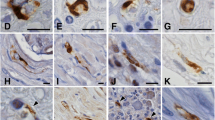Summary
Cryostat sections of two old plaques removed at autopsy from the spinal cord of a 62-year-old man with multiple sclerosis of 24-year duration were studied by indirect immunofluorescence with antibodies to neurofilament proteins, glial fibrillary acidic protein (GFAP), glial hyaluronate-binding protein (GHAP), vimentin and laminin. The neurofilament monoclonal antibodies used in this study reacted with phosphorylated epitopes of the two large polypeptides of the neurofilament triplet (NF 150K, NF 200K). As previously reported [Dahl D, Labkovsky B, Bignami A (1989) Brain Res Bull 22:225–232], the neurofilament antibodies either stained axons in the distal stump of transected sciatic nerve in the early stages of regeneration or late in the process, i.e., after regenerating axons had reached the distal stump of the transected sciatic nerve. Both multiple sclerosis plaques were positive for GFAP and vimentin, but negative for GHAP, while astrocytes in myelinated spinal cord white matter stained with both GFAP and GHAP antibodies. Laminin immunoreactivity in the plaques and normal spinal cord was confined to blood vessels. One plaque was almost devoid of axons as evidenced by indirect immunofluorescence with neurofilament antibodies. Another plaque was packed with bundles of thin axons running an irregular course in the densely gliosed tissue. Axons in the plaque only stained with neurofilament antibodies reacting with sciatic nerve in the early stages of regeneration while axons in the surrounding myelinated white matter were decorated by all neurofilament antibodies, regardless of the time of appearance of immunoreactivity in crushed sciatic nerve. It is concluded that reactive astrocytes forming glial scars do not constitute a non-permissible substrate for axonal growth.
Similar content being viewed by others
References
Allen IV (1984) Demyelinating diseases. In: Adams JH, Corsellis JAN, Duchen LW (eds) Greenfield's neuropathology. Wiley & Sons, New York, pp 338–384
Bielschowsky M (1903) 5. Zur Histologie der multiplen Sklerose. Untersuchungsergebnisse neuer Methoden. Neurol Zentralbl 22:770–777
Bielschowsky M (1904) 4. Die marklosen Nervenfasern in den Herden der multiplen Sklerose. Eine Antwort an Herrn Strähuber. Neurol Zentralbl 23:59–62
Bignami A, Dahl D (1986) Brain-specific hyaluronate-binding protein: an immunohistological study with monoclonal antibodies of human and bovine CNS. Proc Natl Acad Sci USA 83:3518–3522
Bignami A, Dahl D (1986) Brain-specific hyaluronate-binding protein. A product of white matter astrocytes? J Neurocytol 15:671–679
Bignami A, Dahl D, Gilad VH, Gilad GM (1988) Hyaluronate-binding protein produced by white matter astrocytes: an axonal growth repellent? Exp Neurol 100:253–256
Bignami A, Adelman LS, Perides G, Dahl D (1989) Glial hyaluronate-binding protein in polar spongioblastoma. J Neuropathol Exp Neurol 48:187–196
Bignami A, Lane WS, Andrews D, Dahl D (1989) Structural similarity of hyaluronate binding proteins in brain and cartilage. Brain Res Bull 22:67–70
Dahl D, Grossi M, Bignami A (1984) Masking of epitopes in tissue sections. A study of glial fibrillary acidic (GFA) protein with antisera and monoclonal antibodies. Biochemistry 81:525–531
Dahl D, Labkovsky B, Bignami A (1989) Early and late appearance of neurofilament phosphorylation events in nerve regeneration. Brain Res Bull 22:225–232
Doinikow B (1915) Über De-und Regenerationserscheinungen an Achsenzylindern bei der multiplen Sklerose. Z Gesamte Neurol Psychiatr 27:151–178
Greenfield JG (1958) Demyelinating diseases. In: Greenfield JG, Blackwood W, Meyer A, McMenemey WH, Norman RM (eds) Neuropathology. Arnold, London, pp 441–474
Hughes JT, Brownell B (1963) Aberrant nerve fibers within the spinal cord. J Neurol Neurosurg Psychiatry 26:528–534
Perides G, Lane WS, Andrews D, Dahl D, Bignami A (1989) Isolation and partial characterization of a glial hyaluronate-binding protein. J Biol Chem 264:5981–5987
Author information
Authors and Affiliations
Additional information
Supported by NIH grant NS 13034 and by the Veterans Administration
Rights and permissions
About this article
Cite this article
Dahl, D., Perides, G. & Bignami, A. Axonal regeneration in old multiple sclerosis plaques. Acta Neuropathol 79, 154–159 (1989). https://doi.org/10.1007/BF00294373
Received:
Revised:
Accepted:
Issue Date:
DOI: https://doi.org/10.1007/BF00294373




